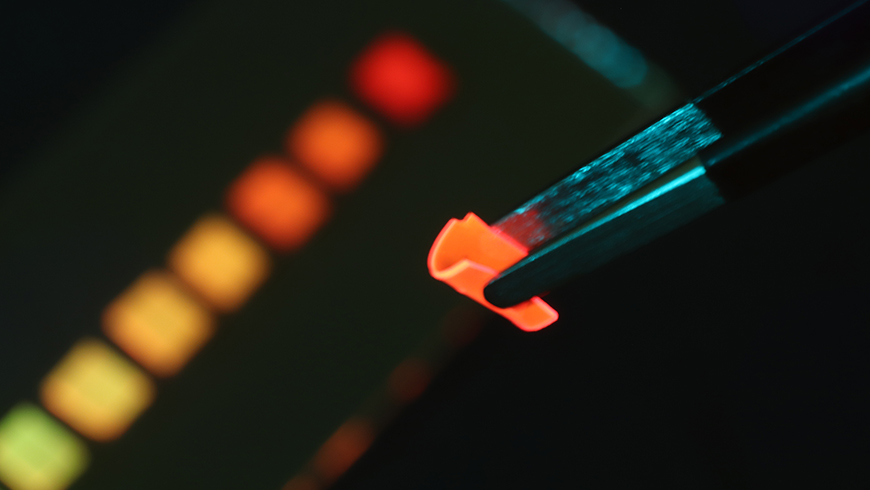Oct 23 2020
Scientists from Empa and ETH Zurich have successfully designed a material with functions similar to a luminescent solar concentrator and possible applications in textiles.
 The newly developed solar concentrator when irradiated with blue LED light: The polymer material is so flexible that it can be bent with tweezers. Image Credit: Empa.
The newly developed solar concentrator when irradiated with blue LED light: The polymer material is so flexible that it can be bent with tweezers. Image Credit: Empa.
The study paves the way to generate energy directly where it is required, for example, while using regular electronics.
The demand for energy has been ever increasing and even continues to increase with the higher supply of new electronic gadgets. Furthermore, humankind is virtually always on the move and hence always relies on the power supply to recharge laptops, tablets, and smartphones.
Going forward, power sockets (at least for this reason) could become outdated. Then, electricity can be obtained from people’s clothes. A new polymer applied to T-shirts, jackets, textile fibers, etc, could soon serve as a solar collector and, thus, as a mobile energy supply.
Making Luminescent Materials Flexible
In the solar industry, materials that can use ambient or indirect light to produce energy are already being used. Such materials include unique luminescent materials and are known as “Luminescent Solar Concentrators” (LSC).
The luminescent materials present in the LSC harness diffuse ambient light and transfer its energy to the real solar cell, which subsequently transforms light into electrical energy. But at present, LSCs are only available as stiff components and are inappropriate for use in textiles as they are neither flexible nor permeable to water vapor and air.
An interdisciplinary research group under the guidance of Luciano Boesel from the Laboratory for Biomimetic Membranes and Textiles has currently been successful in integrating many such luminescent materials into a polymer that offers exactly this air permeability and flexibility.
Well-Known Polymer with Sophisticated Properties
The newly developed material relies on Amphiphilic Polymer Co-Networks (APCN). It is a polymer well-known in research for a long period and is already commercially available in the form of silicone-hydrogel contact lenses.
The polymer’s unique properties—permeability to water vapor and air, as well as stability and flexibility—are also advantageous to the human eye and are based on special chemical properties.
The reason we chose exactly this polymer is the fact that we are capable of incorporating two immiscible luminescent materials at the nano scale and let them interact with each other. There are, of course, other polymers, in which these materials could be integrated; but this would lead to aggregation, and the production of energy would thus not be possible.
Luciano Boesel, Laboratory for Biomimetic Membranes and Textiles, Empa
Bright Solar Concentrators for Clothing
In association with collaborators from two other Empa labs, Thin Films and Photovoltaics and Advanced Fibers, Boesel’s group combined two other luminescent materials to the gel tissue, making it into a flexible solar concentrator.
Similar to large-scale (rigid) collectors, the luminescent materials capture a much broader spectrum of light compared to what is possible with traditional photovoltaics.
The new solar concentrators can be used on textile fibers without making the textile brittle and vulnerable to cracking or water vapor buildup in the form of sweat. Wearable solar concentrators offer a huge advantage for the growing demand for energy, particularly for portable devices.
Journal Reference
Huang, C.-S., et al. (2020) Nano-domains assisted energy transfer in amphiphilic polymer conetworks for wearable luminescent solar concentrators. Nano Energy. doi.org/10.1016/j.nanoen.2020.105039.